Overcoming addiction isn’t a one-and-done victory. In reality, relapse—a return to substance use after a period of abstinence—is a common hurdle faced by many people in recovery.
The frequency of relapse occurrence varies based on factors such as the type of drug involved, demographic characteristics, socioeconomic status, and co-existing mental health conditions.
Here are some key statistics that shed light on how often relapse occurs to help you understand the true scope of this challenge.
KEY TAKEAWAYS
- 40-60% of individuals with addictions experience relapse. These rates are comparable to chronic illnesses like diabetes and hypertension.
- Over 85% of individuals revert to previous substance use patterns within one year post-treatment. Two-thirds of individuals relapse within weeks of starting treatment.
- While relapse rates decrease after the initial 12 months, a 40% risk of drug relapse persists after two years of recovery and a 15% risk persists after five years.
- The number of substances used before treatment significantly impacts the relapse rate. Those using multiple substances are at the highest risk of relapse.
- Alcohol relapse rates range from 40-62% and are influenced by factors like the timing of seeking help and treatment duration.
- People with nicotine and heroin addictions exhibit similar relapse rates of 80-95% over a one-year period.
How Common Is Relapse?
Here are some statistics that help us understand how often relapse occurs:
- According to a 2014 National Institute of Drug Administration (NIDA) publication, the relapse rates of addiction are similar to those of chronic illnesses like diabetes, hypertension, and asthma. NIDA’s statistics suggest that roughly 40 to 60 percent of individuals with addiction will undergo a relapse.
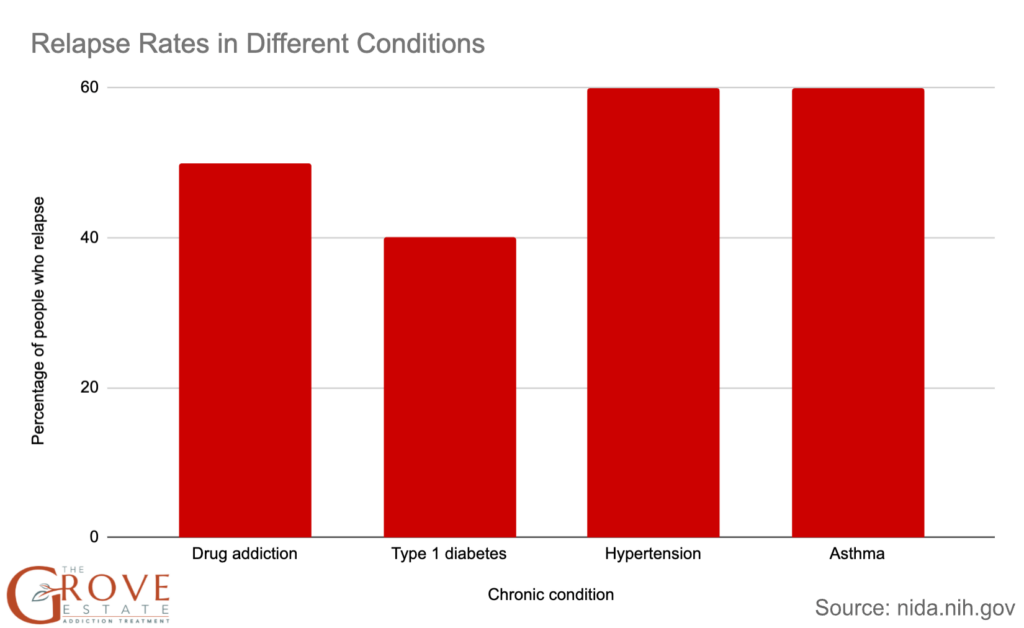
- NIDA’s research shows that over 85% of individuals revert to previous patterns of drug or alcohol use within one year post-treatment. Additionally, two-thirds of individuals resume drug use within a few weeks of starting addiction treatment.
- Addiction relapse rates decrease after the initial twelve months. Nonetheless, even after two years of recovery from substance abuse, there remains a 40% likelihood of drug relapse. The chances of relapse decrease to 15% after five years of treatment.
- According to a 2019 study surveying 607 substance use disorder patients, individuals discharged from short-term treatment clinics (2–4 months) were at a higher risk of relapse compared to those discharged from long-term (6–12 months) clinics. Individuals who completed their inpatient stay showed a decreased risk of relapse.
- In the same study, younger individuals faced a higher likelihood of relapse. The presence of a concurrent mental disorder was also linked to an increased risk of relapse.
- The number of substances used before treatment has been found to affect the rate of relapse. Individuals with two or three different addictions are at the highest rate of relapse.
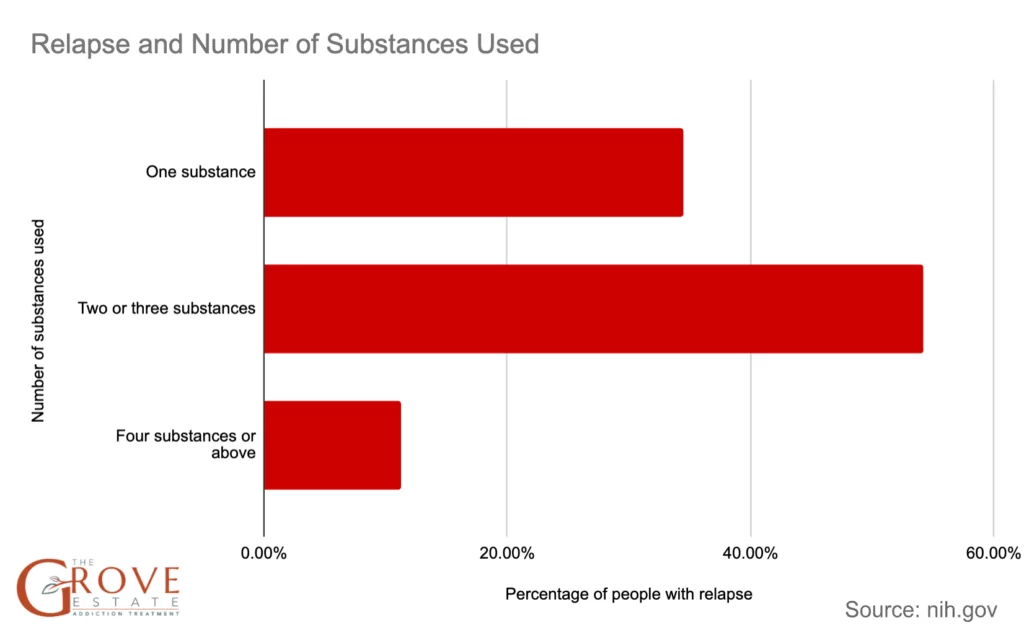
- COVID-19 exacerbated the risk of relapse, as confirmed by multiple pieces of research. The psychosocial COVID-19 factors (like anxiety and depression) and living alone were major risk factors for relapse, according to Frontiers in Psychiatry.
Relapse Rates for Alcohol
Alcohol is a major cause of addiction. Here are some alcohol addiction relapse statistics:
- A study published in the journal Addiction revealed that relapse rates for alcohol addiction ranged from 40 to 62 percent, based on factors such as the timing of seeking help, prior treatment attendance, and duration of addiction struggle.
- Miller and Hester conducted a review of over 500 alcoholism outcome studies, revealing that over 75% of subjects experienced a relapse within one year of treatment.
- The National Institute on Alcohol Abuse and Alcoholism (NIAAA) 2023 report states that around 90% of individuals with a history of alcohol addiction will encounter at least one relapse in their lifetime.
- NIAAA says that between 40-80% of patients undergoing treatment for alcohol use disorders experience at least one drink, known as a “lapse,” within the initial year post-treatment. Approximately 20% of patients revert to alcohol consumption levels similar to those before treatment.
- According to the Journal of Studies on Alcohol, even after maintaining long-term abstinence of over five years, alcoholics face a yearly relapse risk of around 3%.
- In a 2013 Journal of Addictive Diseases survey of 2,820 adults with a background of alcohol dependence and a current episode of major depression, 26% experienced a relapse of alcohol dependence. Those who relapsed were more often male, unmarried, less educated, and younger compared to those who didn’t relapse.
Relapse Rates for Different Drugs
The statistics for relapse for drugs other than alcohol include:
- Research conducted by Hunt and colleagues revealed that nicotine, heroin, and alcohol exhibited remarkably similar rates of relapse over a one-year period that ranged from 80 to 95 percent.
- According to research published in the Indian Journal of Psychological Medicine in 2017, the relapse rates among opioid addicts can reach as high as 91%.
- A study published in Substance Use and Addiction suggests that 75% of those who undergo treatment for stimulant abuse are prone to relapse within the first five years post-treatment. Individuals who use stimulants such as cocaine and amphetamine likely experience a 50% relapse rate within the first year.
- A JAMA Network study indicates that 24% of individuals revert to weekly cocaine use within one year after undergoing treatment. Cocaine relapse rates tend to be higher among individuals with more severe addiction and those who have shorter durations of addiction treatment.
- As per a 2014 Biological Psychiatry journal study, approximately 49 percent of individuals seeking assistance for marijuana addiction experience a relapse within the first 24 hours after marijuana becomes accessible following treatment.
- Here are some relapse rates for substance use disorders from 1994 to 2004, according to The Substance Abuse and Mental Health Services Administration (SAMHSA).
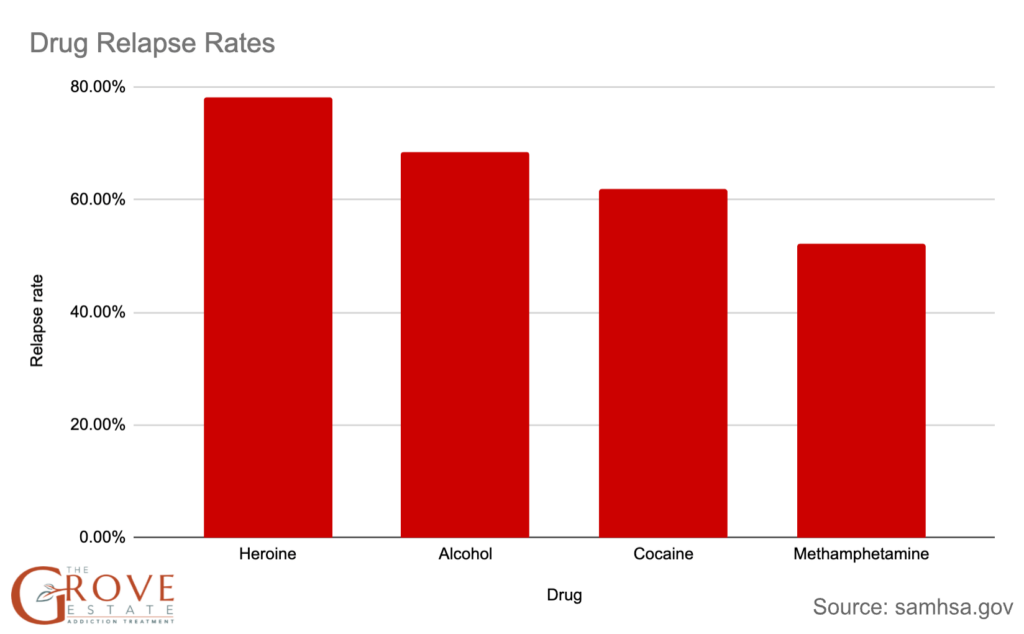
Substance Use Relapse Association With Mental Health
Relapse is associated with mental health conditions. Here is what the statistics say:
- A Biological Psychology study mentions that increased mental health symptoms are associated with reduced impulse control and consequently negatively impact impulsive behaviors like substance use relapse.
- According to a 2021 Psychiatry study, substance use severity and frequency were markedly linked to high emotion dysregulation.
- In a longitudinal study published in 2022, participants who relapsed exhibited notably longer reaction times on the Conners’ Continuous Performance Test (CPT) compared to those who did not relapse. The CPT is a computer-based assessment evaluating attention, impulsivity, inattention, sustained attention, and vigilance through a GO/NO-GO task.
- According to the same study, mental health distress serves as a relatively immediate predictor of relapse, while variations in cognition and craving are the most reliable indicators of subsequent craving intensity and relapse.
Reasons and Risk Factors for Relapse
There are multiple reasons why people relapse. Here are some statistics on the topic:
- The primary reasons for relapse reported in a 2017 study in the Indian Journal of Psychological Medicine are the desire for a better mood, sleep problems, and cravings.
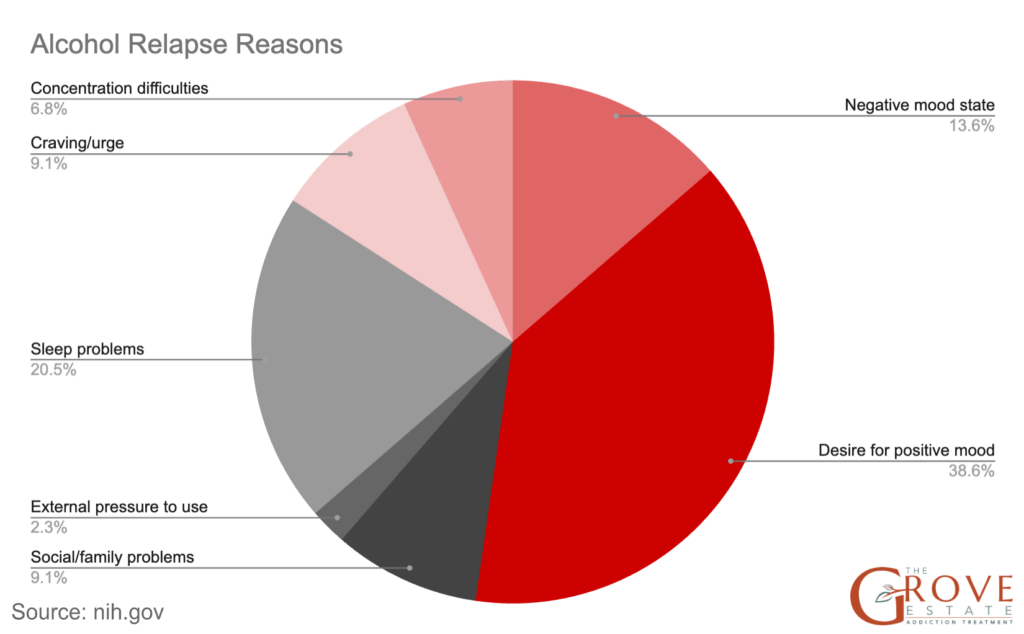

- According to a Journal of Psychoactive Drugs study published in 2022, the likelihood of relapse within a three-month period was predicted by the desire to stop substance use, the risk of depression, being on probation, and employment status.
- By the twelfth month, the intensity of substance use and the motivation to quit were the key factors associated with relapse.
- As per a 2021 BMC study, the primary contributing factors to relapse were peer group influence and family-related stressors. Additionally, participants had a higher likelihood of relapse if they were living with peers or drug dealers or experiencing intra-family conflicts.
- The same study revealed that patients hospitalized for shorter durations, precisely one to three months, were significantly more likely to relapse compared to those hospitalized for more than three months.
- A 2024 study published in the Journal of Substance Abuse and Addiction Treatment established a positive correlation between substance use disorder relapse and family conflicts, friendships with individuals struggling with addiction, and having addicted close relatives.
What Percentage of Patients Relapse After Their First Year?
An estimated 85% of people with alcohol or drug-related addiction issues relapse within a year after starting treatment. 40–80% of patients undergoing treatment for alcohol use disorders experience a “lapse” within the first year post-treatment. Individuals using stimulants like cocaine and amphetamine face a 50% relapse rate within the first year.
How to Reduce the Risk of Relapse?
Here are some strategies to reduce the risk of relapse:
- Develop coping skills to manage triggers and stressors
- Participate in support groups or therapy and establish a strong support network
- Maintain a healthy lifestyle, including regular exercise and balanced nutrition
- Avoid situations or environments associated with substance use
- Stay engaged in recovery activities
Can Medication Help Prevent Alcohol Relapse?
Yes, medications such as naltrexone, acamprosate, or a combination of both have shown to be effective in preventing alcohol relapse. Naltrexone demonstrated better outcomes regarding time to first drink and relapse compared to acamprosate in clinical trials. The combined naltrexone and acamprosate treatment was the most effective.
What is the impact of peer support on relapse prevention?
Peer support plays a pivotal role in relapse prevention by providing emotional support, shared experiences, and accountability. According to Healthline, engaging with peer support groups can offer encouragement and practical advice for maintaining sobriety. These groups foster a sense of community and belonging, which is crucial for individuals feeling isolated in their recovery journey.
The effectiveness of peer support is also emphasized in structured environments like residential rehab, where individuals benefit from both professional care and the solidarity of peers facing similar challenges. For more detailed insights, exploring statistics for substance abuse in medical professionals can reveal how peer support within professional networks also contributes to sustained recovery and reduced relapse rates.
Data Sources
2. https://www.ncbi.nlm.nih.gov/pmc/articles/PMC5688890/
3. https://www.ncbi.nlm.nih.gov/pmc/articles/PMC1976118/
4. https://www.hazeldenbettyford.org/articles/relapse-risks-stats-and-warning-signs
5. https://jamanetwork.com/journals/jamanetworkopen/fullarticle/2719577
6. https://www.ncbi.nlm.nih.gov/pmc/articles/PMC3522776/
7. https://www.niaaa.nih.gov/alcohols-effects-health/alcohol-topics/alcohol-facts-and-statistics
8. https://www.ncbi.nlm.nih.gov/pmc/articles/PMC8801433/
9. https://jamanetwork.com/journals/jamapsychiatry/fullarticle/1673778
10. https://pubmed.ncbi.nlm.nih.gov/34553671/
11. https://www.sciencedirect.com/science/article/pii/S0306460318308542?via%3Dihub#s0050
12. https://www.ncbi.nlm.nih.gov/pmc/articles/PMC7851925/
13. https://www.frontiersin.org/journals/psychiatry/articles/10.3389/fpsyt.2020.620612/full
14. https://www.theguardian.com/world/2020/mar/28/americans-addiction-rrelapse-coronavirus
15. https://www.sciencedirect.com/science/article/pii/S2949875923002953
16. https://jamanetwork.com/journals/jamapsychiatry/fullarticle/207038
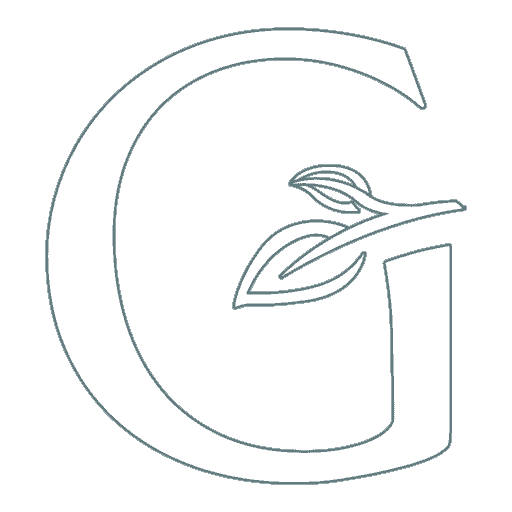
Share This Post



